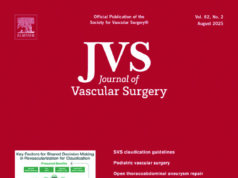Exercise can play an important role in treating peripheral arterial disease (PAD), a recent review by Amy Harwood, PhD, from the Centre for Sport and Exercise Life Sciences at Coventry University and the faculty of health sciences at the University of Hull in the U.K., et al shows.

The review was published in the British Medical Journal (BMJ) Open Sport and Exercise Medicine. The review concluded that, for people with PAD, exercise programs may help improve walking ability and quality of life by relieving symptoms of leg pain, cramps, and fatigue.
PAD affects 236 million people across the world. While some people with this disease experience no symptoms, approximately 30% experience pain, cramps, numbness, and intermittent claudication. Intermittent claudication is more common in adults over 50, men and people who smoke.
Currently, PAD treatments focus on managing symptoms and preventing atherosclerotic narrowing of the arteries, which will also reduce the risk of heart disease and stroke. Medications may also be prescribed to reduce cholesterol or treat high blood pressure, which are both risk factors for developing PAD.
Managing intermittent claudication is especially important as people who have it are at a higher risk of other cardiovascular diseases, such as heart disease and stroke. On top of this, the leg pain they experience means people often cannot walk very far. This could lead to lower fitness levels and reduced quality of life. It may also cause depression, as people are no longer as independent as they would like to be in their daily life.
But exercise programs may offer another treatment approach for people with intermittent claudication, Harwood and colleagues claim. Evidence from their latest review shows exercise can help increase the distance patients can walk pain-free, and may reduce the risk of heart disease and stroke. “We also uncovered what it takes for an exercise program to be successful,” they write in a press release.
“We found that for people with intermittent claudication, a supervised, walking-based exercise program is most likely to improve their symptoms. This program should ideally be done at least three times per week for a minimum of three months. Patients should try to walk at a challenging pace (meaning it causes them to experience strong leg pain) for three to five minutes before resting until the pain goes away. The walk-rest pattern should be repeated for about 30 to 60 minutes.”
This type of exercise program was shown to significantly improve claudication symptoms, as indicated by an increase in the distance a person can walk without pain. It also increases quality of life and overall fitness levels.
“Revascularization or drug treatment options should only be considered in patients if exercise training provides insufficient symptomatic relief,” Harwood and her co-authors conclude.
For those who cannot access a supervised walking program, the authors say that exercise can still be done independently, and should also be carried out at least three times a week for 30 to 60 minutes each time. The reviewers recommend people start walking regularly for exercise at their own pace, building up their walking speed and time gradually. “Monitoring how far you walk with an app or smartwatch may be helpful,” they say.
The review also found that resistance exercise (such as lifting weights) can help to improve muscle strength in patients with intermittent claudication. Resistance exercises can be used alongside a walking program and can be done two to three times per week with each session including exercises for the main muscles of the upper and lower body.
“It is worth noting that people with intermittent claudication should not worry about walking with leg pain, because this pain does not equate to harm being caused,” Harwood et al write. “Claudication pain is thought to be a result of insufficient blood flow to the exercising muscle. Walking while experiencing claudication pain could, over time, stimulate the growth of new blood vessels in the legs and improve symptoms.”
Patients are advised not to exercise if they feel unwell and to seek medical advice if they experience any concerning symptoms when they do exercise—such as chest pain, dizziness, or sickness.
“Our review shows exercise can help manage claudication pain, and may limit the progression of atherosclerotic disease throughout the body. Regular exercise may improve claudication pain in several ways, including improving the way blood vessels work and helping the leg muscles use oxygen more efficiently. Not only can this exercise be done alone or as part of a supervised program, but it may also have other benefits, including improving cardiovascular health, mood, and sleep.”












